 By now, Airto must have released about 30 LPs and played on and spiced up countless albums, yet Free may still be his best. Simply because the conditions were perfect: there are Chick Corea and Keith Jarrett on piano, Ron Carter on bass, the master himself on drums and percussion, Hubert Laws and Joe Farrell on reeds, George Benson on guitar, Don Sebesky with exceptionally good arrangements directing a big band of super-professionals and Rudy van Gelder making sure the recording sound is crystal . There’s a very good version of Return To Forever, there’s this little gem, Lucky Southern on which Keith Jarrett plays a wonderful solo, and there’s the highlight, Flora’s Song and again, it’s Keith Jarrett who along with Don Sebesky, gets the crown. Airto himself? Not just his percussion is top, but also his drumming. A joyful event, whenever the record is played. –Yofriend
By now, Airto must have released about 30 LPs and played on and spiced up countless albums, yet Free may still be his best. Simply because the conditions were perfect: there are Chick Corea and Keith Jarrett on piano, Ron Carter on bass, the master himself on drums and percussion, Hubert Laws and Joe Farrell on reeds, George Benson on guitar, Don Sebesky with exceptionally good arrangements directing a big band of super-professionals and Rudy van Gelder making sure the recording sound is crystal . There’s a very good version of Return To Forever, there’s this little gem, Lucky Southern on which Keith Jarrett plays a wonderful solo, and there’s the highlight, Flora’s Song and again, it’s Keith Jarrett who along with Don Sebesky, gets the crown. Airto himself? Not just his percussion is top, but also his drumming. A joyful event, whenever the record is played. –Yofriend
Jazz
David Axelrod “Song of Innocence” (1968)
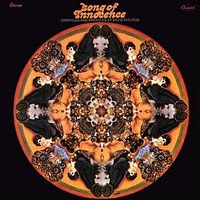 Trying to put a tag on the music of legendary producer David Axelrod is almost impossible as his music, especially [when] early offerings such as this, straddles so many genres. You get funk, jazz, classical and rock all thrown into the melting pot to create a rather unique sound that has had a large influence on many people. Nowhere has this been more apparent than in hip hop and trip hop where this LP has been heavily sampled. If you are a fan of those two genres prepare to hear a lot of familiar breaks when you hear this record for the first time. The LP itself was heavily influenced by the poetry of William Blake hence there is a dark brooding feel throughout and Axelrod uses layers of strings playing minor keys to obtain this mood. The drums and percussion drive the music on and there are some fantastic guitar breaks. –Jon
Trying to put a tag on the music of legendary producer David Axelrod is almost impossible as his music, especially [when] early offerings such as this, straddles so many genres. You get funk, jazz, classical and rock all thrown into the melting pot to create a rather unique sound that has had a large influence on many people. Nowhere has this been more apparent than in hip hop and trip hop where this LP has been heavily sampled. If you are a fan of those two genres prepare to hear a lot of familiar breaks when you hear this record for the first time. The LP itself was heavily influenced by the poetry of William Blake hence there is a dark brooding feel throughout and Axelrod uses layers of strings playing minor keys to obtain this mood. The drums and percussion drive the music on and there are some fantastic guitar breaks. –Jon
Cannonball Adderley “At the Lighthouse” (1961)
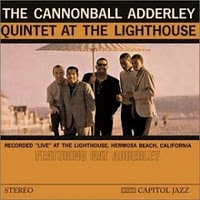 Cannonball Adderley is a tremendously joyful performer. It’s the trait that makes him such a great foil for melancholy Miles on their collaborations. It’s also the trait that makes At the Lighthouse such a beautiful album. A lot of jazz music is aimed at expanding boundaries, or breaking them down entirely. A great deal of the most highly regarded work is exploratory in nature, and that exploration can be breath-taking. There is something to be said, however, for simplicity. The musicians on At the Lighthouse never force a note. Each solo is in complete service of the song, rather than taking the first opportunity to bust free of the song’s framework. The rhythm section of Sam Jones and, particularly, drummer Louis Hayes are economical and straight-forward. Adderley and his brother Nat deliver lovingly crafted solos and have a precise but easy-going chemistry when playing together. The real stand-out, in my mind, is pianist Victor Feldman. He always waits patiently for his solo (always third) and accentuates the rhythm section. Then, he takes the reigns and delivers these long, eloquent solos while still helping to propel the song along. Really lovely stuff. If your thing is Ascension and The Shape of Jazz to Come, and you’re only interested in the outer edge of jazz, then this album may not be for you. If you just love great music, however, then this magical, casual recording of a night at a club in 1960 will make you smile, guaranteed. –Lucas
Cannonball Adderley is a tremendously joyful performer. It’s the trait that makes him such a great foil for melancholy Miles on their collaborations. It’s also the trait that makes At the Lighthouse such a beautiful album. A lot of jazz music is aimed at expanding boundaries, or breaking them down entirely. A great deal of the most highly regarded work is exploratory in nature, and that exploration can be breath-taking. There is something to be said, however, for simplicity. The musicians on At the Lighthouse never force a note. Each solo is in complete service of the song, rather than taking the first opportunity to bust free of the song’s framework. The rhythm section of Sam Jones and, particularly, drummer Louis Hayes are economical and straight-forward. Adderley and his brother Nat deliver lovingly crafted solos and have a precise but easy-going chemistry when playing together. The real stand-out, in my mind, is pianist Victor Feldman. He always waits patiently for his solo (always third) and accentuates the rhythm section. Then, he takes the reigns and delivers these long, eloquent solos while still helping to propel the song along. Really lovely stuff. If your thing is Ascension and The Shape of Jazz to Come, and you’re only interested in the outer edge of jazz, then this album may not be for you. If you just love great music, however, then this magical, casual recording of a night at a club in 1960 will make you smile, guaranteed. –Lucas
Centipede “Septober Energy” (1971)
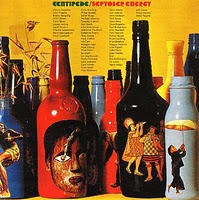 This ominous double LP has been sitting there in my record collection since 1973. I don’t know why I haven’t played it for ages, I used to play it a lot. So, the first of October is an apt day to play and review Septober Energy. It is a project assembled by Keith Tippett and produced by Robert Fripp (both members of King Crimson at the time). These two gathered virtually the entire creative British music scene – a who-is-who of some 50 musicians, horns, brass, strings, singers, Alan Skidmore, Elton Dean, Ian Carr, Alan Skidmore, Paul Rutherford, John Marshall, Robert Wyatt, Ian MacDonald, Boz Burrell, Julie Driscoll (Tippett at the time of recording), just to name a few. The music sounds as if Tippett and Fripp were struggling to find a home for their jazzier, freer ideas which they couldn’t incorporate into the King Crimson concept.
This ominous double LP has been sitting there in my record collection since 1973. I don’t know why I haven’t played it for ages, I used to play it a lot. So, the first of October is an apt day to play and review Septober Energy. It is a project assembled by Keith Tippett and produced by Robert Fripp (both members of King Crimson at the time). These two gathered virtually the entire creative British music scene – a who-is-who of some 50 musicians, horns, brass, strings, singers, Alan Skidmore, Elton Dean, Ian Carr, Alan Skidmore, Paul Rutherford, John Marshall, Robert Wyatt, Ian MacDonald, Boz Burrell, Julie Driscoll (Tippett at the time of recording), just to name a few. The music sounds as if Tippett and Fripp were struggling to find a home for their jazzier, freer ideas which they couldn’t incorporate into the King Crimson concept.
There are moments of grandezza, pathos, Jazz-Rock passages, Free Jazz – both loud and aggressive and soft and gentle, Bolero-like crescendos, concert music, sheet music, smashing arrangements and orchestrations, all of it played live in the studio and simultaneously recorded. Of course, due to the concept, there are also passages which don’t succeed or which are too long – I’m thinking of the finale. Septober Energy has been put down as megalomania, usually from King Crimson fans. I don’t agree. It’s difficult music, certainly. You have to make an effort to follow the music. It might just not be your taste. But that doesn’t make it a flop. Septober Energy is like nothing else from the early seventies, it’s an important musical document from one of the most exiting musical phases in the twentieth century. I’m glad I re-discovered this album. It’s out on CD and should not be overlooked. –Yofriend
Miles Davis “Nefertiti” (1968)
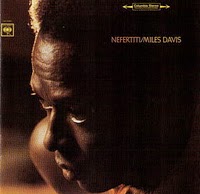 I wish I’d been a fly on the wall, no, a fly on producer Teo Macero’s shoulder during the classic sessions which yielded this album and the rest of the quintet’s catalogue in the late 60s. Creative tension probably doesn’t even begin to describe the atmosphere. Strangely, there are no Davis compositions here, but Wayne Shorter weighs in with the first two tracks – the slightly off key, circular title track and beautiful Hand Jive. On the latter, the sax is a true wonder in his hands, soulful, searching, graceful. I much prefer the version of Herbie Hancock’s Riot heard here, rather than on his own album Speak Like A Child. It’s slightly faster, with an almost mambo, Latin sounding tempo. –Neal
I wish I’d been a fly on the wall, no, a fly on producer Teo Macero’s shoulder during the classic sessions which yielded this album and the rest of the quintet’s catalogue in the late 60s. Creative tension probably doesn’t even begin to describe the atmosphere. Strangely, there are no Davis compositions here, but Wayne Shorter weighs in with the first two tracks – the slightly off key, circular title track and beautiful Hand Jive. On the latter, the sax is a true wonder in his hands, soulful, searching, graceful. I much prefer the version of Herbie Hancock’s Riot heard here, rather than on his own album Speak Like A Child. It’s slightly faster, with an almost mambo, Latin sounding tempo. –Neal
Eric Dolphy “Out There” (1960)
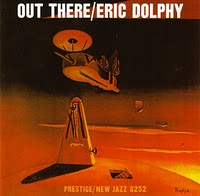 At first Out There sounds like an Ornette Coleman album, but then you realize that Eric Dolphy has twisted Coleman’s weird ideas around his even stranger finger. I mean…legendary bassist Ron Carter plays cello. Cello!!! George Duvivier plays bass. What a stroke of genius. There’s less musicians on Out There than on Dolphy masterpiece Out To Lunch. In fact, Dolphy is the only horn period. He puts in mind blowing solos on alto sax, flute, b-flat clarinet and bass clarinet. If I had to choose the most talented reed and woodwind player of all time it would be a tie between Eric Dolphy and Rahsaan Roland Kirk. While Kirk absolutely mastered more than 50 instruments, Dolphy can make a clarinet sound drop-dead sexy one moment and convince you that the world is ending the next. The same goes for any instrument that he played. “Sketch of Melba” has some stunning flute playing. –Rob
At first Out There sounds like an Ornette Coleman album, but then you realize that Eric Dolphy has twisted Coleman’s weird ideas around his even stranger finger. I mean…legendary bassist Ron Carter plays cello. Cello!!! George Duvivier plays bass. What a stroke of genius. There’s less musicians on Out There than on Dolphy masterpiece Out To Lunch. In fact, Dolphy is the only horn period. He puts in mind blowing solos on alto sax, flute, b-flat clarinet and bass clarinet. If I had to choose the most talented reed and woodwind player of all time it would be a tie between Eric Dolphy and Rahsaan Roland Kirk. While Kirk absolutely mastered more than 50 instruments, Dolphy can make a clarinet sound drop-dead sexy one moment and convince you that the world is ending the next. The same goes for any instrument that he played. “Sketch of Melba” has some stunning flute playing. –Rob
James Blood Ulmer “Tales of Captain Black” (1979)
 “HOLY CRAP!” is a good summary of my reaction to Tales of Captain Black. If you ever wanted to hear a Jazz album that could match…make that surpass Captain Beefheart’s Trout Mask Replica then this is it. It’s a Free-Jazz-Post-Punk-Polka-Funk-Blues merry-go-round, pushing the limits of any music listener’s tolerance levels. The most famous member of the band is certainly Ornette Coleman. He’s great company for James Blood Ulmer. You can hear briefly from time to time that Ulmer is a great Blues guitarist as well, when he’s not being a demon. Bassist Jamaaladeen Tacuma books it at light speed. And Denardo Coleman’s performance makes me wonder if anyone has ever recorded the drumming tracks for an album by mounting a small drum kit to a horse, having their beats thrown off by galloping and bucking of freaked-out horse as they rode it around the studio. That would be pretty “Free-Jazz” of them. –Rob
“HOLY CRAP!” is a good summary of my reaction to Tales of Captain Black. If you ever wanted to hear a Jazz album that could match…make that surpass Captain Beefheart’s Trout Mask Replica then this is it. It’s a Free-Jazz-Post-Punk-Polka-Funk-Blues merry-go-round, pushing the limits of any music listener’s tolerance levels. The most famous member of the band is certainly Ornette Coleman. He’s great company for James Blood Ulmer. You can hear briefly from time to time that Ulmer is a great Blues guitarist as well, when he’s not being a demon. Bassist Jamaaladeen Tacuma books it at light speed. And Denardo Coleman’s performance makes me wonder if anyone has ever recorded the drumming tracks for an album by mounting a small drum kit to a horse, having their beats thrown off by galloping and bucking of freaked-out horse as they rode it around the studio. That would be pretty “Free-Jazz” of them. –Rob
Santana “Welcome” (1973)
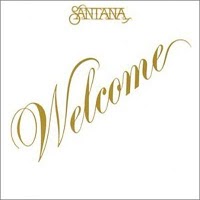 Welcome stands between two popular Santana LPs, Caravanserei and Borboletta, and it’s perhaps the most underrated Santana album. Like the previous LP, Welcome has a recording sound which can easily match today’s standards. This band had it all. The album opens with an instrumental meditation dominated by Alice Coltrane’s organ sound. The first highlight is Samba de Sausalito with a marvelous undercurrent of percussion and a good e-piano solo by Tom Coster. The next song, When I Look Into Your Eyes is a light Pop tune greatly upvalued by Joe Farrell’s lovely flute solo and the band’s accompaniment and the adventurous production: Leon Thomas uses his yodel as a sound effect and Richard Kermode comes in with a super-funky keyboard riff on which the song fades out. Next is one of my all-time Santana favorites, Yours Is The Light featuring Flora Purim, a Brazilian rhythm, Leon Thomas’ whistling and a very disciplined yet inspired solo by Carlos himself. Side Two starts with another great instrumental, Mother Africa recalling Earth, Wind & Fire’s Head To The Sky from the same year, Coltrane (Jules Brussard’s soprano solo) and McCoy Tyner. Light Of Life evokes the atmosphere of Gato Barbieri’s soundtrack, Last Tango In Paris. And now, the most ambitious instrumental piece on the set, Flame-Sky introducing John McLaughlin. In the face of this guitar giant, however, Carlos does not shy away, he opens with a typical yet inspired solo; the band shows they hold up to any challenge and finally, the Mahavishnu does what he does so well until they duet. The title song closes the circle of this marvelous LP in a quiet way with a meditation. A fantastic LP from beginning to end. The sound engineer can’t be praised too high. Welcome sounds as good today as it sounded back then, a musical adventure and one of the best Rock albums of the 70s. –Yofriend
Welcome stands between two popular Santana LPs, Caravanserei and Borboletta, and it’s perhaps the most underrated Santana album. Like the previous LP, Welcome has a recording sound which can easily match today’s standards. This band had it all. The album opens with an instrumental meditation dominated by Alice Coltrane’s organ sound. The first highlight is Samba de Sausalito with a marvelous undercurrent of percussion and a good e-piano solo by Tom Coster. The next song, When I Look Into Your Eyes is a light Pop tune greatly upvalued by Joe Farrell’s lovely flute solo and the band’s accompaniment and the adventurous production: Leon Thomas uses his yodel as a sound effect and Richard Kermode comes in with a super-funky keyboard riff on which the song fades out. Next is one of my all-time Santana favorites, Yours Is The Light featuring Flora Purim, a Brazilian rhythm, Leon Thomas’ whistling and a very disciplined yet inspired solo by Carlos himself. Side Two starts with another great instrumental, Mother Africa recalling Earth, Wind & Fire’s Head To The Sky from the same year, Coltrane (Jules Brussard’s soprano solo) and McCoy Tyner. Light Of Life evokes the atmosphere of Gato Barbieri’s soundtrack, Last Tango In Paris. And now, the most ambitious instrumental piece on the set, Flame-Sky introducing John McLaughlin. In the face of this guitar giant, however, Carlos does not shy away, he opens with a typical yet inspired solo; the band shows they hold up to any challenge and finally, the Mahavishnu does what he does so well until they duet. The title song closes the circle of this marvelous LP in a quiet way with a meditation. A fantastic LP from beginning to end. The sound engineer can’t be praised too high. Welcome sounds as good today as it sounded back then, a musical adventure and one of the best Rock albums of the 70s. –Yofriend
McCoy Tyner “The Real McCoy” (1967)
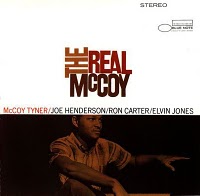 Yes! Here we have the album that lifts Tyner out of the shadow of Coltrane and propels him to deity status in jazz. A formidable pianist with a unique style Tyner was the defining muscular pianist whose hard aggressive block right hand chords and subtle left hand work made him eay to recognise and even easier to admire. With this album he simply explodes in every sense. His playing has never been bettered and it seems that all shackles are off. What also stands out is the stunning maturity of his compostion. This has the best opening of any jazz album with the romping Passion Dance and the perfectly titled Contemplation. Ron Carter has never sounded better either and Jones has a telepathic understanding with Tyner as is to be expected after so many years together. This would be in my ten jazz albums as a collection starter for any new or aspiring jazz fan. –Jon
Yes! Here we have the album that lifts Tyner out of the shadow of Coltrane and propels him to deity status in jazz. A formidable pianist with a unique style Tyner was the defining muscular pianist whose hard aggressive block right hand chords and subtle left hand work made him eay to recognise and even easier to admire. With this album he simply explodes in every sense. His playing has never been bettered and it seems that all shackles are off. What also stands out is the stunning maturity of his compostion. This has the best opening of any jazz album with the romping Passion Dance and the perfectly titled Contemplation. Ron Carter has never sounded better either and Jones has a telepathic understanding with Tyner as is to be expected after so many years together. This would be in my ten jazz albums as a collection starter for any new or aspiring jazz fan. –Jon
Sam Rivers “Contours” (1965)
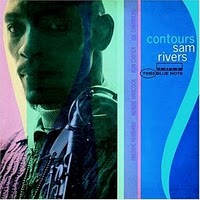 Along with True Blue by Tina Brooks this is one of those Blue Note LPs that is painfully rare and unheard. What a shame as it is an absolute classic. Very different in feel to Brooks but just as essential. Avant Garde yet never forgetting to swing and what a line up: Hubbard, Hancock, Carter and Chambers! That should be worth the price of the LP alone but Rivers stamps his authority all over the set which is no mean feat in this company. His solos are at times tempered and sensitive and at other times scream with bursts of noise from the speakers. Carter and Hubbard are also on great form. The album also highlights what a great composer Rivers was. –Jon
Along with True Blue by Tina Brooks this is one of those Blue Note LPs that is painfully rare and unheard. What a shame as it is an absolute classic. Very different in feel to Brooks but just as essential. Avant Garde yet never forgetting to swing and what a line up: Hubbard, Hancock, Carter and Chambers! That should be worth the price of the LP alone but Rivers stamps his authority all over the set which is no mean feat in this company. His solos are at times tempered and sensitive and at other times scream with bursts of noise from the speakers. Carter and Hubbard are also on great form. The album also highlights what a great composer Rivers was. –Jon
Gil Scott-Heron “Pieces of a Man” (1971)
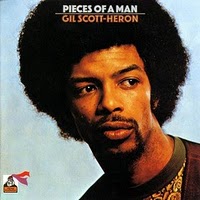 The song “The Revolution Will Not Be Televised” is the earliest incidence of rap that I’ve heard so far. What’s more, it features the flute playing of Hubert Laws. That’s right, flute in a rap song. The next thing that really struck me was the bass. None other than Ron Carter makes the switch to electric bass, reminding me of Jaco Pastorius a little bit. Those three musicians form a deadly trio. Hubert Laws only plays on three songs, I think. That’s not much of an issue though because he wouldn’t have really fit in many of the other songs. The style of the music varies from fusion on the first half to soul and jazz on the rest of the record. What takes the album from being good to being great is the fact that everyone can identify with the lyrics about the plight of African Americans and subjects like depression. “Lady Day and John Coltrane” feels more like a statement about the power of music in general to enhance you life, with John Coltrane and Billie Holiday used as examples. Scott-Heron has made it known on his records that he’s a huge fan of Coltrane. Kind of makes a person wonder what kind of crazy supergroup would have been inevitable had a few people not died prematurely. Let’s say Coltrane lived on. Heron might have used Ron Carter to recruit Coltrane into this band. Pretty much wherever Coltrane went, Elvin Jones followed, so they wouldn’t have had to look far for a drummer. So far we’ve got flute, vocal, drums, sax and bass. What about guitar? The only right person for the job would have Jimi Hendrix, yet another victim of too much celebrity. Maybe throw John’s talented wife Alice in on piano and harp. Voila! Potentially one of the best supergroups that will never be. It’s sad, really. What I like better about this album versus Free Will is the presence of Ron Carter and that the lyrics are still political but don’t go so far as to border on being anti-white. It’s one thing to stick up for your people but it’s other to sound like you’re verbally attacking another group in the process. Let’s not fight hate with hate. Pieces of a Man was released the same year as What’s Going On by Marvin Gaye, has just as much political and social commentary, might be better, and yet gets a meager amount of recognition in comparison. Yup, that’s about how much sense I’ve come to expect from the music world. –Rob
The song “The Revolution Will Not Be Televised” is the earliest incidence of rap that I’ve heard so far. What’s more, it features the flute playing of Hubert Laws. That’s right, flute in a rap song. The next thing that really struck me was the bass. None other than Ron Carter makes the switch to electric bass, reminding me of Jaco Pastorius a little bit. Those three musicians form a deadly trio. Hubert Laws only plays on three songs, I think. That’s not much of an issue though because he wouldn’t have really fit in many of the other songs. The style of the music varies from fusion on the first half to soul and jazz on the rest of the record. What takes the album from being good to being great is the fact that everyone can identify with the lyrics about the plight of African Americans and subjects like depression. “Lady Day and John Coltrane” feels more like a statement about the power of music in general to enhance you life, with John Coltrane and Billie Holiday used as examples. Scott-Heron has made it known on his records that he’s a huge fan of Coltrane. Kind of makes a person wonder what kind of crazy supergroup would have been inevitable had a few people not died prematurely. Let’s say Coltrane lived on. Heron might have used Ron Carter to recruit Coltrane into this band. Pretty much wherever Coltrane went, Elvin Jones followed, so they wouldn’t have had to look far for a drummer. So far we’ve got flute, vocal, drums, sax and bass. What about guitar? The only right person for the job would have Jimi Hendrix, yet another victim of too much celebrity. Maybe throw John’s talented wife Alice in on piano and harp. Voila! Potentially one of the best supergroups that will never be. It’s sad, really. What I like better about this album versus Free Will is the presence of Ron Carter and that the lyrics are still political but don’t go so far as to border on being anti-white. It’s one thing to stick up for your people but it’s other to sound like you’re verbally attacking another group in the process. Let’s not fight hate with hate. Pieces of a Man was released the same year as What’s Going On by Marvin Gaye, has just as much political and social commentary, might be better, and yet gets a meager amount of recognition in comparison. Yup, that’s about how much sense I’ve come to expect from the music world. –Rob
Charles Mingus “Oh Yeah” (1962)
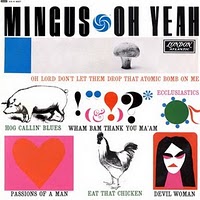 That Mingus had in mind to do something different on this record can be divined by the fact that he plays piano instead of bass here. And he sings … badly. Plus he hires both Roland Kirk and Booker Ervin to play sax — and if you can think of two more disparate players, send your answers on a postcard to me. The end result is one of Mingus’ earthiest, bluesiest, craziest and, well, most unhinged albums; if the songwriting isn’t up to, say, Ah Um, it makes up for it in sheer loopiness. “Passions of a Man” is the most avant-garde and complicated track here, perfectly balanced by the sleazy R&B of “Eat That Chicken”. And who can disagree with the sentiments of “Oh Lord Don’t Let Them Drop That Atomic Bomb On Me”? Unsung hero: Dannie Richmond. Again. –Neal
That Mingus had in mind to do something different on this record can be divined by the fact that he plays piano instead of bass here. And he sings … badly. Plus he hires both Roland Kirk and Booker Ervin to play sax — and if you can think of two more disparate players, send your answers on a postcard to me. The end result is one of Mingus’ earthiest, bluesiest, craziest and, well, most unhinged albums; if the songwriting isn’t up to, say, Ah Um, it makes up for it in sheer loopiness. “Passions of a Man” is the most avant-garde and complicated track here, perfectly balanced by the sleazy R&B of “Eat That Chicken”. And who can disagree with the sentiments of “Oh Lord Don’t Let Them Drop That Atomic Bomb On Me”? Unsung hero: Dannie Richmond. Again. –Neal


